Swallowtail Butterfly
Group of butterflies is called a kaleidoscope.
Advertisement
Swallowtail Butterfly Scientific Classification
Read our Complete Guide to Classification of Animals.
Swallowtail Butterfly Conservation Status
Swallowtail Butterfly Locations

Swallowtail Butterfly Facts
- Prey
- plant nectar
- Main Prey
- plant nectar
- Name Of Young
- larva (caterpillar); the pupa (chrysalis)
- Group Behavior
- Solitary
- Fun Fact
- Group of butterflies is called a kaleidoscope.
- Estimated Population Size
- With 500+ species of swallowtails, its difficult accurately estimate population size.
- Biggest Threat
- habitat destruction and climate change
- Most Distinctive Feature
- colorful, swallow-like tails
- Distinctive Feature
- large size, distinctive markings
- Other Name(s)
- Swallowtail butterflies are comprised of over 500 species, including Black Swallowtail, Zebra Swallowtail, Spicebush Swallowtail, and Pipeline Swallowtail.
- Gestation Period
- Swallowtail eggs hatch in approximately 4 days; Caterpillars become pupas in about two weeks;
- Temperament
- docile, solitary; males can be aggressive when defending territory or mating.
- Wingspan
- 2-4 inches
- Training
- N/A
- Optimum pH Level
- N/A
- Incubation Period
- N/A
- Age Of Independence
- birth
- Age Of Fledgling
- N/A
- Average Spawn Size
- 300-700
- Litter Size
- 300-700
- Habitat
- Worldwide except Antarctica
- Predators
- Birds, lizards, snakes, spiders
- Diet
- Herbivore
- Average Litter Size
- 300-700
- Lifestyle
- Diurnal
- Solitary
- Favorite Food
- nectar
- Type
- Papilionidae
- Common Name
- Swallowtail
- Special Features
- Swallow-like tail
- Location
- worldwide except in Antarctica
- Slogan
- N/A
- Group
- kaleidoscope
- Nesting Location
- under leaves, between rocks
- Age of Molting
- N/A
- Migratory
- 1
Swallowtail Butterfly Physical Characteristics
- Color
- Brown
- Grey
- Yellow
- Fawn
- Blue
- Black
- White
- Tan
- Dark Brown
- Cream
- Orange
- Chocolate
- Skin Type
- Exoskeleton
- Lifespan
- 2-4 weeks
- Weight
- 0.0014 - 0.0105 ounces
- Height
- 1-2 inches
- Length
- 2-4 inch wingspan
- Age of Sexual Maturity
- approx. 1-2 weeks
- Age of Weaning
- N/A
- Venomous
- No
- Aggression
- Medium
View all of the Swallowtail Butterfly images!
Did you know that there are approximately 600 species of Swallowtail butterflies? Swallowtail butterflies, in the family Papilionidae, have distinctive tail-like extensions on their hindwings, which resemble the tails of swallows. Swallowtails live on every continent except Antarctica. They typically feed on nectar from flowers and are important pollinators. Keep reading to learn more about Swallowtail butterflies.
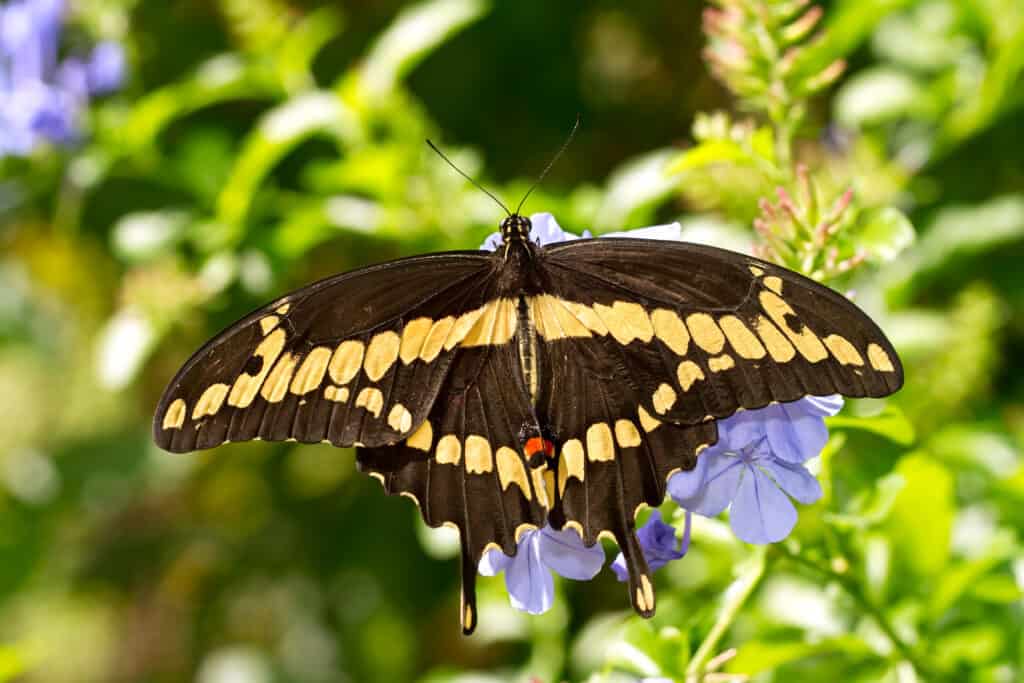
Swallowtails live on every continent except Antarctica.
©Lorraine Hudgins/Shutterstock.com
Incredible Swallowtail Butterfly Facts:
- Swallowtail butterflies have a distinctive forked tail on their hind wings that resembles a swallow’s tail, which gives them their name.
- The caterpillars of some swallowtail species have a false head on the back of their bodies, which they can use to distract predators.
- The Eastern Tiger Swallowtail butterfly is one of the most common and widely distributed swallowtail species in North America.
- The Black Swallowtail butterfly has a wingspan of up to 4 inches and is found in gardens and meadows.
- Adult Swallowtails feed on nectar from flowers, while the caterpillars feed on plants such as dill, fennel, and parsley.
- Some species of swallowtail butterflies, such as the Papilio polytes, exhibit mimicry in which females mimic inedible species for protection against predators.
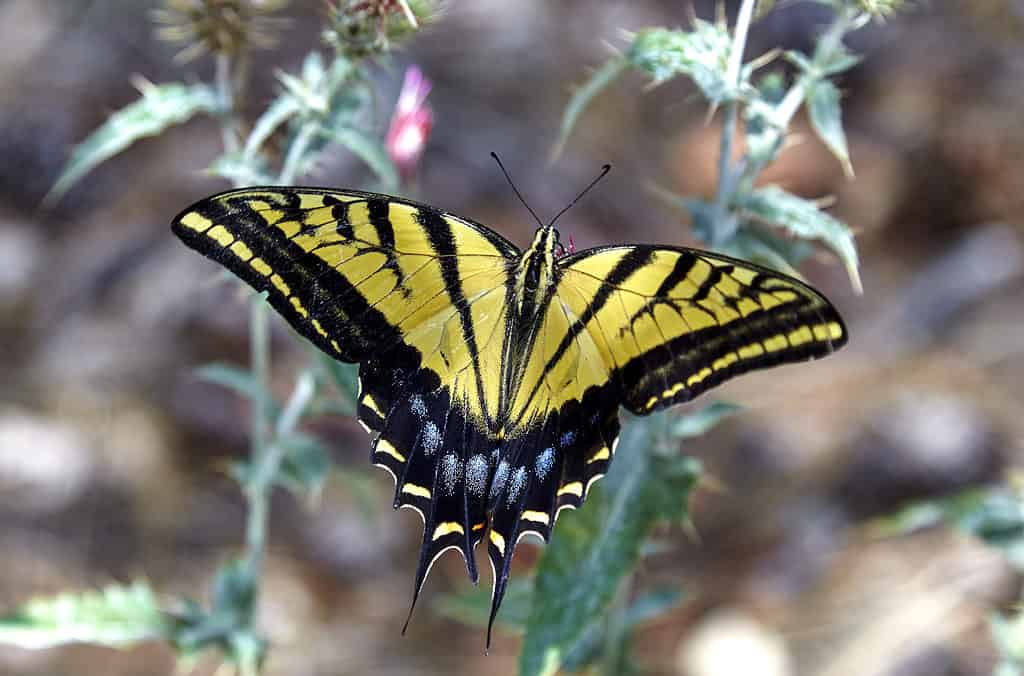
Swallowtail butterflies have distinctive forked tails on their hind wings.
©Pamela Au/Shutterstock.com
Swallowtail Butterfly: Scientific Name
The scientific name for the swallowtail butterfly is Papilionidae, which is Latin for butterfly. There are about 600 separate species of swallowtail butterflies. Each one of these species has a unique scientific name. For example, the old world Swallowtail butterfly is the Papilo machaon. It is named for the Greek physician Machaon, who is said to have been able to heal wounds with the help of swallowtail butterflies. The tiger swallowtail, Papilio glaucus, is a brightly colored swallowtail revered for its orange and black tiger stripes. Papilo, which is Latin for butterfly, and glaucus, which is Latin for bright, gleaming, or sparkling, references the tiger swallowtail’s bright colors.
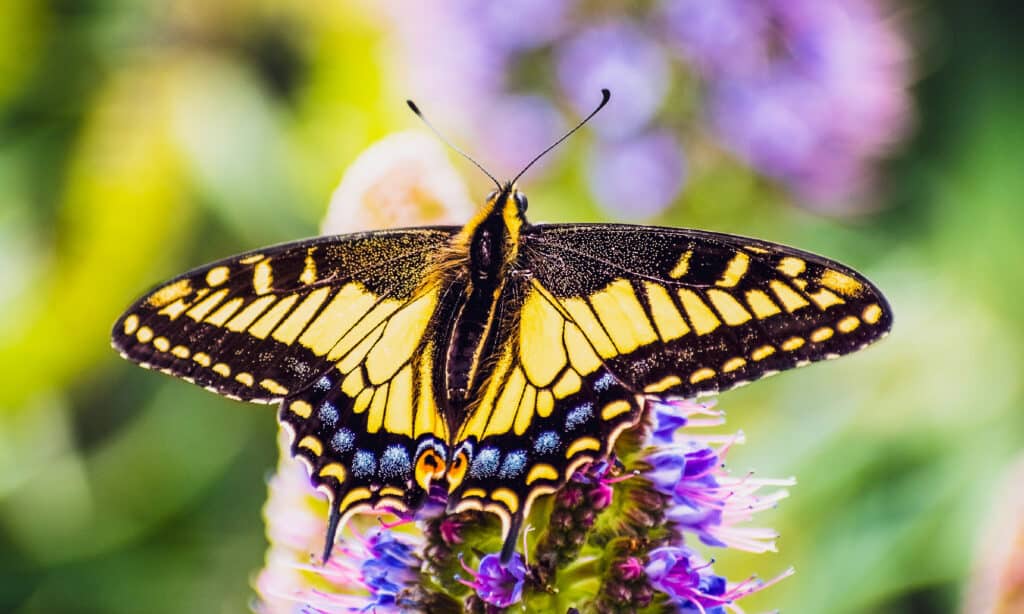
The tiger swallowtail,
Papilio glaucus, is a brightly colored swallowtail revered for its orange and black tiger stripes.
©iStock.com/Sundry Photography
Swallowtail Butterfly: Appearance and Behavior:
Swallowtail butterflies have large, colorful wings, patterned with black and yellow or black and white. They have a distinctive tail on their hindwings, which gives them their name. The body of a swallowtail butterfly is typically thin and elongated, and they have large, compound eyes. The wingspan of a swallowtail butterfly can range from 5 – 15 centimeters (2 to 6 inches). Swallowtails weigh between 0.04 – 0.3 grams (0.0014 – 0.0105 ounces).
Swallowtails are active during the day, flying and feeding on nectar from flowers. They are strong fliers that have a distinctive flutter flight pattern when they are looking for a place to rest. Though swallowtails are typically solitary creatures, they will occasionally gather to puddle. Puddling involves a group of swallowtails coming together in marshy, damp areas to acquire the nutrients that have leeched from the soil.
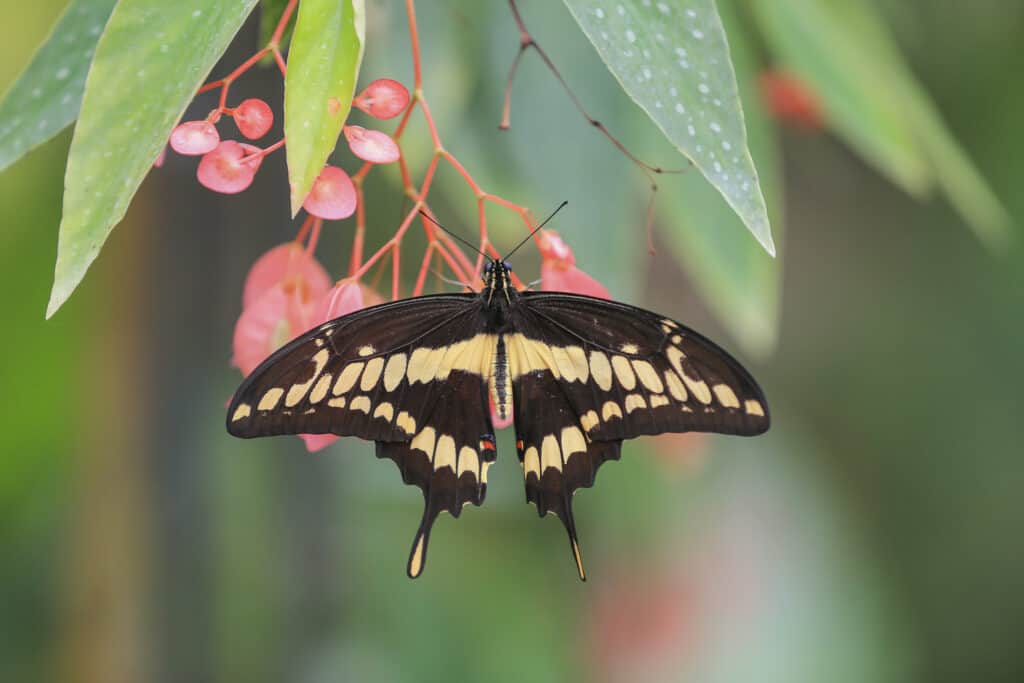
Swallowtail butterflies have large, colorful wings, patterned with black and yellow or black and white.
©iStock.com/rybalov77
Though usually docile creatures, male swallowtails can become quite aggressive during mating season and when defending their territory. Adult female swallowtails typically lay their eggs on the leaves of host plants, which include fennel, parsley, and dill. Once the eggs hatch, the caterpillars feed on the leaves.
Swallowtail Butterfly: Habitat
Swallowtails are found everywhere in the world except for Antarctica. A swallowtail butterfly’s habitat can vary depending on the species, but many species are found in wooded areas, gardens, and fields. They are typically found near sources of nectar, such as flowers, as well as near their host plants, fennel, parsley, and dill, which are used for laying eggs. Some species live near swamps, marshes, or rainforests. Other species prefer mountainous or coastal areas. Swallowtails are less common in arid or desert regions. Overall, swallowtail butterflies live in a wide variety of habitats, but they all require a source of nectar and a host plant for their survival.
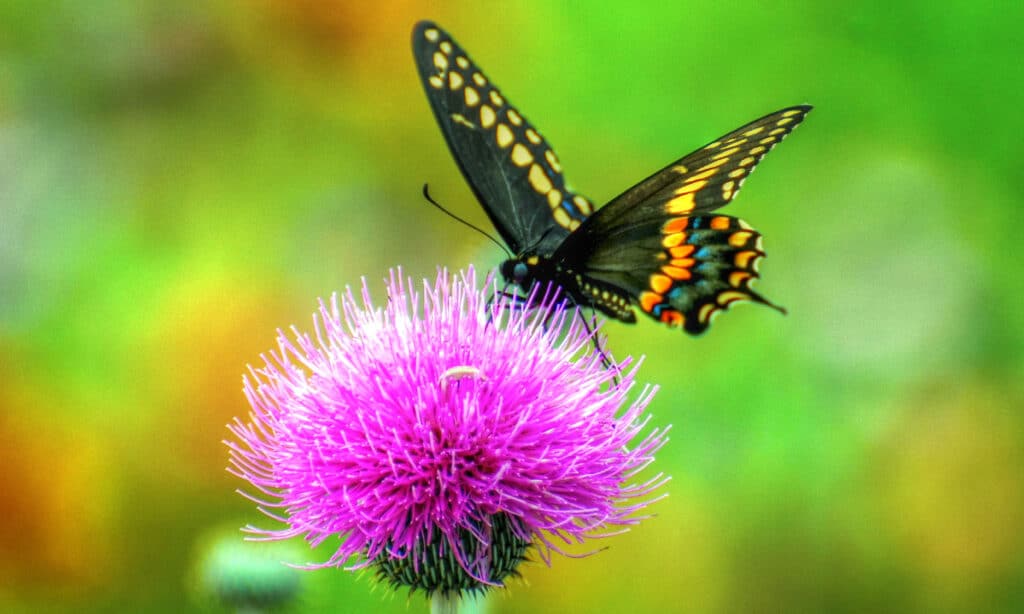
A swallowtail butterfly’s habitat can vary depending on the species, but many species are found in wooded areas, gardens, and fields.
©iStock.com/wayne stockburger
Migration
Swallowtail butterflies, including species such as the Eastern Tiger Swallowtail and the Canadian Tiger Swallowtail, migrate seasonally. These migrations typically occur in the spring and fall and may involve butterflies traveling hundreds or even thousands of miles. The triggers and mechanisms that affect migration are not fully understood. They are thought to be influenced by such factors as temperature, food availability, and changes in daylight. Some species of swallowtail butterflies have multiple generations in a year. The young of the second and third generations may migrate to different regions. This leads to the establishment of new populations. Swallowtails may be seen in large numbers, during migration, with individuals flying in a southwesterly direction during the spring and a northeasterly direction during the fall.
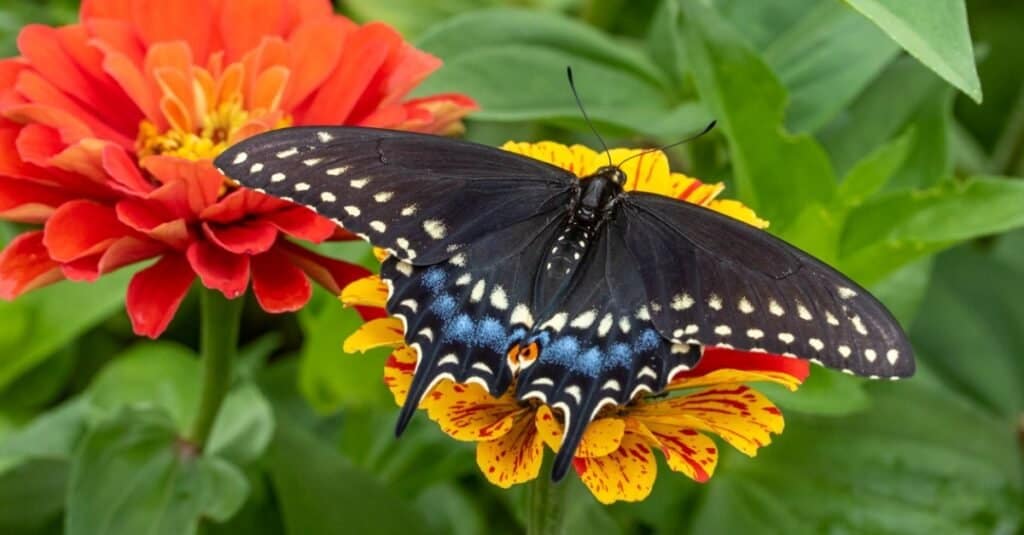
Swallowtail butterflies migrate seasonally.
©Melody Mellinger/Shutterstock.com
Swallowtail Butterfly: Diet
Colorful swallowtail butterflies have a diverse diet, which includes a variety of different plants. They feed on the nectar of a wide range of flowers, including thistles, clovers, and milkweeds. Some species of swallowtail butterflies also feed on rotting fruit and tree sap. Swallowtails have a preference for red, orange, and yellow flowers. Their diet plays a key role in their survival and reproduction.
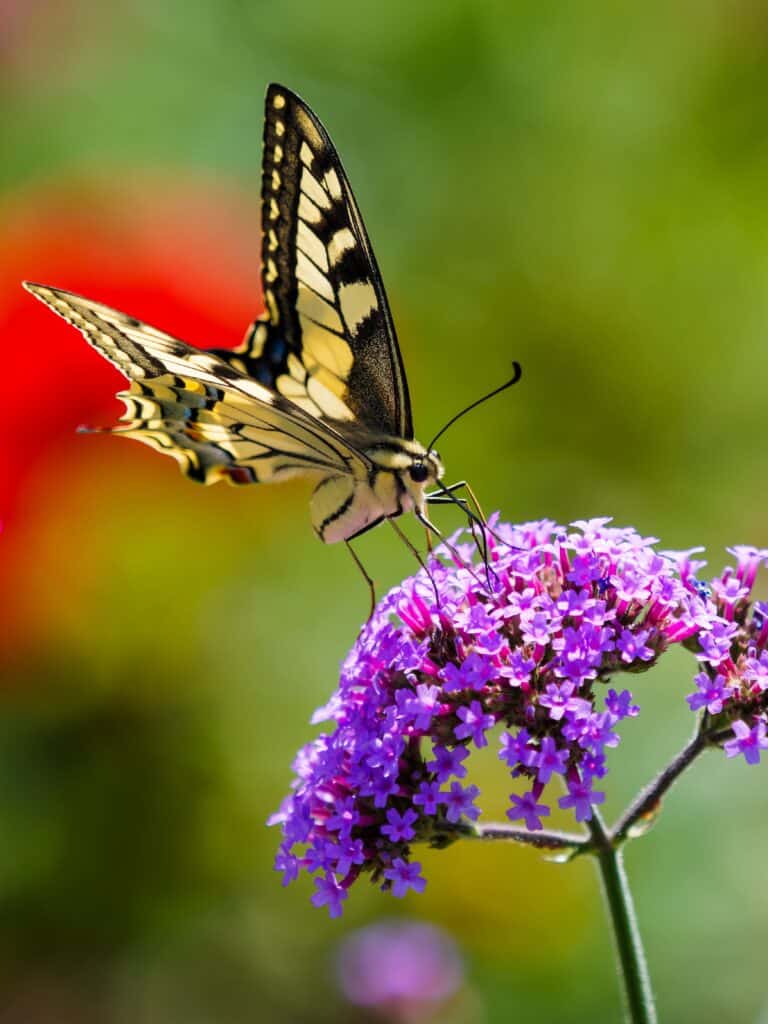
Swallowtails feed on plant nectar.
©MacBen/Shutterstock.com
Swallowtail Butterfly: Predators and Threats
Swallowtail butterflies, like many other butterfly species, have a variety of natural predators. Birds such as robins and bluejays are known to eat adult butterflies, while lizards and spiders may prey on both adult butterflies and their larvae.
Habitat destruction is a major threat to swallowtail butterflies and many other species. Swallowtail butterflies lose their host plants, nectar sources, and breeding sites, as natural areas are cleared for human development or agriculture. Pesticides, which are used to control crop pests, can also be toxic to butterflies, killing both adult butterflies and their larvae.
Climate change is also affecting swallowtail butterfly populations. Rising temperatures and changing precipitation patterns can affect the timing of butterfly emergence, migration, and mating, leading to mismatches between butterflies and their food plants. Warmer temperatures may also lead to an increase in the range and population of predators, such as birds and insects that feed on butterflies, further reducing butterfly populations.
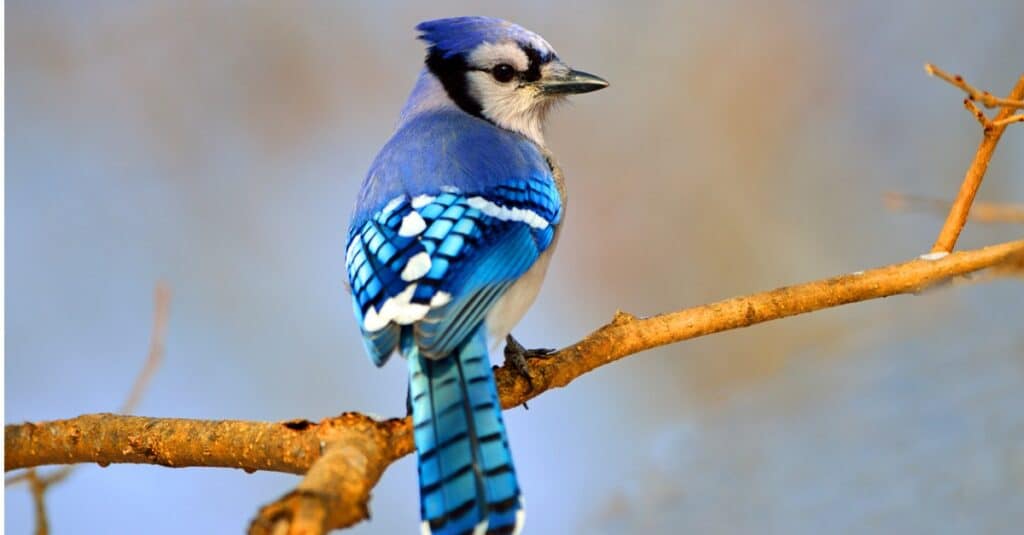
Birds such as bluejays are known to eat adult butterflies.
©iStock.com/BrianEKushner
Conservation Status
Some species of swallowtail butterflies are considered endangered or threatened, while others are not. For example, The Schaus’ swallowtail butterfly (Heraclides aristodemus ponceanus) is listed as an endangered species in the U.S. The Eastern tiger swallowtail’s(Papilio glaucus) conservation status is classified as one of least concern. The status of a particular species can vary depending on factors such as population size, distribution, and the threats it faces. The population of swallowtail butterflies varies depending on the specific species and location.

Habitat destruction is destabilizing to certain swallowtail species.
©Rich Carey/Shutterstock.com
Some populations may be stable or increasing, while others may be decreasing. Factors such as habitat loss, pollution, and climate change affect swallowtail populations. The availability of their host plants and the presence of natural predators affect the swallowtail population. Conservation efforts, such as habitat restoration and protection, can help to support and improve swallowtail butterfly populations. It is important to note that the conservation status of a species can change over time as a result of changes in population size or the severity of threats it faces.
Swallowtail Butterfly: Lifecycle
The lifecycle of a swallowtail butterfly typically includes four stages: egg, larva (caterpillar), pupa (chrysalis), and adult. The female butterfly lays her eggs on the leaves of host plants. The eggs hatch into larvae (caterpillars), which feed on the leaves or stems of host plants. After several weeks of feeding and growing, the caterpillar enters the pupal stage, where it forms a chrysalis. Inside the chrysalis, the caterpillar undergoes metamorphosis and emerges as an adult butterfly.
Adult swallowtail butterflies have a lifespan of about 2 to 4 weeks.
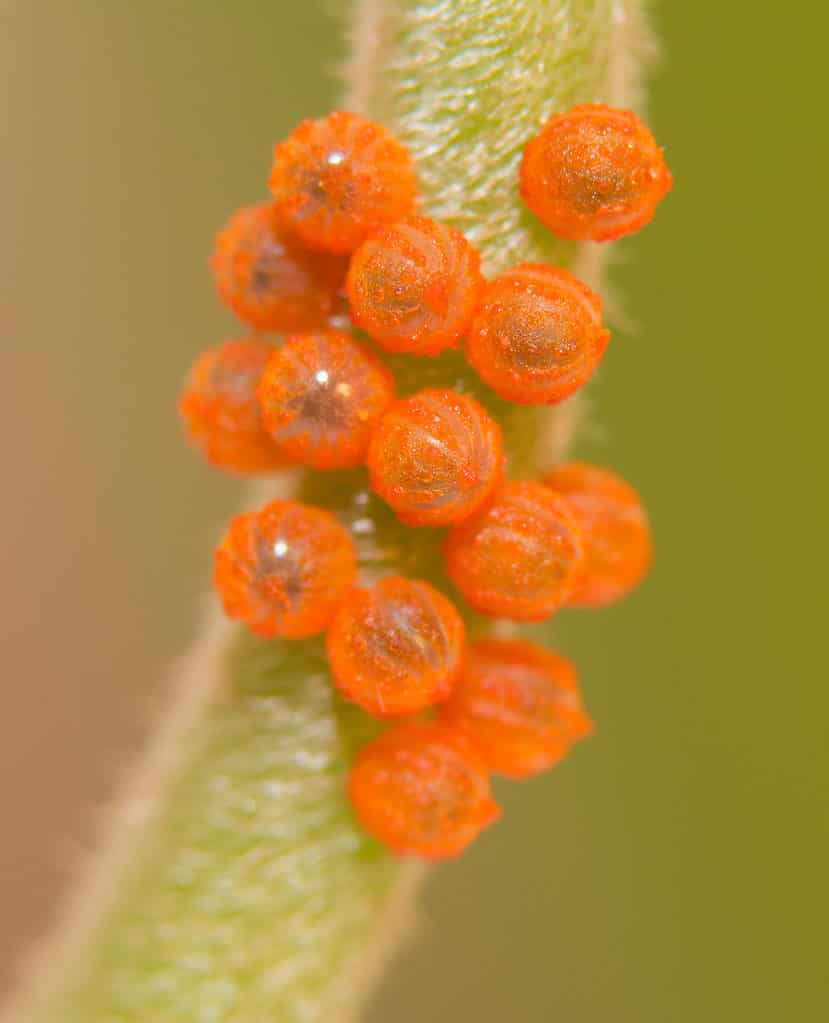
The female butterfly lays her eggs on the leaves or stems of host plants.
©Sari ONeal/Shutterstock.com
Up Next:
View all 293 animals that start with SSwallowtail Butterfly FAQs (Frequently Asked Questions)
How any different species of swallowtail butterflies are there?
There are approximately 600 different species of swallowtail butterflies
How big are Swallowtail butterflies?
Swallowtail butterflies are on the larger side, with wingspans 0f 2 -4 inches.
How many eggs does a female Swallowtail butterfly lay?
a female swallowtail butterfly will lay an average of 300-700 eggs over a period of 1-5 days.
What is the average lifespan of a swallowtail butterfly?
The average lifespan of a swallowtail butterfly is 2-4 weeks.
What do Swallowtail butterflies eat?
Swallowtail butterflies primarily feed on plant nectar.
Thank you for reading! Have some feedback for us? Contact the AZ Animals editorial team.
Sources
- butterfly.com, Available here: https://www.butterflyidentification.com/swallowtail-papilionidae
- naba.org, Available here: https://www.naba.org/chapters/nabanj/butterflies/eastern_tiger_swallowtail.html
- wikipedia.org, Available here: https://en.wikipedia.org/wiki/Swallowtail_butterfly
















